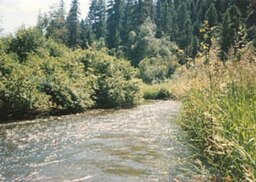Sanpoil River
| Sanpoil River | |
| Country | United States |
|---|---|
| State | Washington |
| Tributaries | |
| - right | West Fork Sanpoil River |
| City | Republic |
| Source | |
| - elevation | 2,735 ft (834 m) |
| - coordinates | 48°38′54″N 118°38′12″W / 48.64833°N 118.63667°W |
| Mouth | Columbia River |
| - elevation | 1,293 ft (394 m) |
| - coordinates | 47°56′55″N 118°40′50″W / 47.94861°N 118.68056°WCoordinates: 47°56′55″N 118°40′50″W / 47.94861°N 118.68056°W |
| Length | 70 mi (113 km) |
| Basin | 981 sq mi (2,541 km2) |
The Sanpoil River (also spelled San Poil) is a tributary of the Columbia River, in the U.S. state of Washington. The term Sanpoil is from the Okanagan term [snpʕʷílx], meaning "people of the gray country", or "gray as far as one can see".
The Sanpoil River originates near the city of Republic, in the Okanagan Highland, east of the Okanogan River. It flows south through the Colville National Forest, Okanogan National Forest, and the Colville Indian Reservation. After entering the reservation the river receives its main tributary, the West Fork Sanpoil River. It then receives a number of smaller tributaries such as Twentyone Mile Creek, Twentythree Mile Creek, and Thirty Mile Creek.
The Sanpoil River enters Franklin D. Roosevelt Lake (FDR Lake), the impounded Columbia River above Grand Coulee Dam. The dam impounded the last few miles of the Sanpoil River as well. This part of FDR Lake is called Sanpoil Arm. Like many tributaries of the Columbia River, the Sanpoil River had a major salmon run before the river was dammed.
Relatively low numbers of adfluvial wild rainbow trout and hatchery-released kokanee salmon return to the Sanpoil River from Lake Roosevelt. Smallmouth bass and walleye, two nonindigenous predators that stage at the river/lake interface during the juvenile migration season, are thought to consume large numbers of these species. To determine the percentage that were consumed, Stroud et al. (2010, 2011) used bioenergetic models linked to population estimates. They estimate that the predators consumed 105 (95% CI, 86-162)% of the 0.5–year kokanee salmon, 39 (33-68)% of the 1.5–year kokanee salmon, 74 (60-118)% of the 1–year rainbow trout and 53 (44-92)% of the 2 and 3–year old rainbow trout in a 113-day study window.
...
Wikipedia

